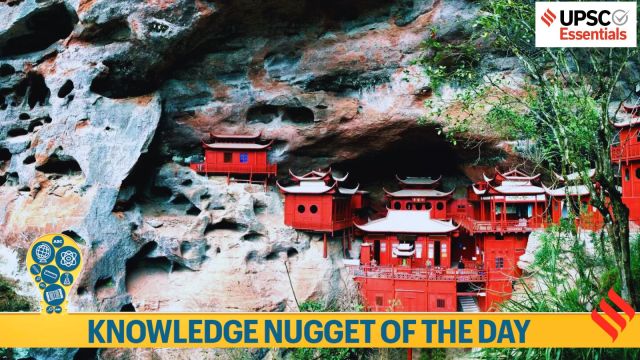
Key Takeaways :
1. UNESCO Global Geoparks are single, unified geographical areas where sites and landscapes of international geological significance are managed with a comprehensive approach of protection, education and sustainable development.
Story continues below this ad
2. According to UNESCO’s official site, “A UNESCO Global Geopark uses its geological heritage, in connection with all other aspects of the area’s natural and cultural heritage, to enhance awareness and understanding of key issues facing society, such as using our earth’s resources sustainably, mitigating the effects of climate change and reducing natural hazard-related risks.”
3. Global Geoparks are established through a bottom-up approach of combining conservation with sustainable development while involving all relevant local and regional stakeholders and authorities in the area.
4. At present, there are 229 UNESCO Global Geoparks in 50 countries. North Korea recorded its historic first with the inclusion of its site in the UNESCO Global Geoparks Network, while Saudi Arabia has made its debut on the list with two newly designated geoparks.
5. As of April 30, 2025, India does not have any UNESCO Global Geoparks. While India has identified several geological heritage sites and is exploring the idea of developing geoparks, none have yet been recognised by UNESCO.
Story continues below this ad
Criteria to be a UNESCO Global Geopark
The criteria for an area to become a UNESCO Global Geopark are set out in the Operational Guidelines for UNESCO Global Geoparks. There are four fundamental features to a UNESCO Global Geopark.
1. Geological heritage of international value: The area must have geological heritage of international value.
2. Effective management structure: UNESCO Global Geoparks are managed by a body having legal existence recognized under national legislation.
3. Visibility: UNESCO Global Geoparks promote sustainable local economic development mainly through geotourism. To stimulate the geotourism in the area, it is crucial that a UNESCO Global Geopark has visibility.
Story continues below this ad
4. Networking: Membership of the Global Geoparks Network (GGN) is obligatory for UNESCO Global Geoparks.
Is the designation of UNESCO Global Geoparks fixed?
Notably, sites are given the designation of UNESCO Global Geoparks for a period of four years after which the functioning and quality of each UNESCO Global Geopark is thoroughly re-examined during a revalidation process. According to UNESCO’s official site-
1. If, on the basis of the field evaluation report, the UNESCO Global Geopark continues to fulfill the criteria, the area will continue as a UNESCO Global Geopark for a further four-year period (so-called “green card”).
2. If the area no longer fulfills the criteria, the management body will be informed to take appropriate steps within a two-year period (so-called “yellow card”).
Story continues below this ad
3. Should the UNESCO Global Geopark not fulfill the criteria within two years after receiving a “yellow card”, the area will lose its status as a UNESCO Global Geopark (so-called “red card”).
BEYOND THE NUGGET: New literary works in UNESCO’s Memory of the World (MoW) Programme
• UNESCO’s Memory of the World (MoW) programme, launched in 1992, is an international cooperation strategy aimed at safeguarding, protecting, and facilitating access to and the use of documentary heritage, particularly rare and endangered heritage.
• Beginning in 1997, the Register has been biennally updated, with the exception of a lengthy gap between 2017 and 2023, with between nine (in 1999) and 78 (in 2017) additions. In any year, at most two submissions from a country are added.
• Recently, manuscripts of the Bhagavad Gita and Bharat Muni’s Natyashastra are added to UNESCO’s Memory of the World Register, taking the total number of inscriptions from India in the list to 14.
Story continues below this ad
📍Natyashastra: Natyashastra is an ancient Sanskrit treatise on performing arts. It is traditionally attributed to the sage Bharata. Comprising 36,000 verses, the “Naṭyashastra embodies a comprehensive set of rules that define natya (drama), abhinaya (performance), rasa (aesthetic experience), bhava (emotion), sangita (music),” the UNESCO citation says.
📍Bhagavad Gita: Bhagavad Gita is a Sanskrit scripture comprising 700 verses that are organised in 18 chapters, embedded in the sixth book (Bhishma Parva) of the epic poem Mahabharata. It is traditionally attributed to the sage Vyasa.
• Notably, last year, three Indian literary works — Ramcharitmanas, Panchatantra, and Sahṛdayaloka-Locana—were added to UNESCO’s Memory of the World Asia-Pacific Regional Register. let’s also know about these literary works.
📍Ramcharitmanas: This manuscript was authored by Goswami Tulsidas.
📍Panchatantra: Attributed to Vishnu Sharma, this is an ancient Indian collection of interrelated animal fables in verse and prose.
Story continues below this ad
📍Sahṛdayaloka-Locana: Written by 15th-century Kashmiri scholars Acharya Anandvardhan and Abhinavagupta, it was chosen for its aesthetic significance.
Post Read Question
Consider the following statements with reference to the Global Geoparks:
1. They are managed by UNESCO.
2. Recently, North Korea recorded its historic first with the inclusion of its site in the UNESCO Global Geoparks Network.
3. India has six Global Geoparks sites.
How many of the statements given above are correct?
(a) Only one
(b) Only two
(c) All three
(d) None
Subscribe to our UPSC newsletter. Stay updated with the latest UPSC articles by joining our Telegram channel – Indian Express UPSC Hub, and follow us on Instagram and X.
🚨 Click Here to read the UPSC Essentials magazine for April 2025. Share your views and suggestions in the comment box or at Manas Srivastava 🚨


































